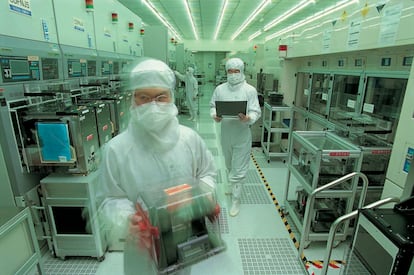How the world is entering an age of security economics
The Covid pandemic, the war in Ukraine and tension between the West and China have caused a paradigm shift in which resilience has gained ground over efficiency

The world is entering a new economic era, marked by a paradigm shift in which the criteria of national security, strategic autonomy and resilience in the face of numerous risks are gaining ground over traditional efficiency.
The Covid pandemic, the war in Ukraine and the growing tensions between the West and China have come together to drive a shift towards security economics — both in terms of public policy and in business decisions.
The turnaround is taking shape in multiple areas. Manufacturing and energy supply chains are being re-organized; governments are encouraging the development of strategic technologies via large public investments, or activating protectionist mechanisms, while the defense industry is heading towards a phase of considerable evolution and expansion of productive capacities. Financial flows in the private sector are being altered, in terms of international investments, bond holdings and the use of particular currencies in trade.
“We are witnessing a global turn from a criterion of pure efficiency to a much more prudent and balanced attitude. The trigger is the realization that interdependence has been turned into a weapon,” explains Zaki Laïdi, a professor at the Paris Institute of Political Studies (better known as Sciences Po) in Paris specializing in the political dimensions of globalization. He is also a senior adviser to Josep Borrell, High Representative of the European Union for Foreign Affairs and Security Policy.
“The geopolitical situation is increasingly weighing on the decisions of public authorities and companies,” agrees Judith Arnal, a senior research fellow at the Elcano Royal Institute in Madrid.
“We’re in an increasingly polarized world. This was an issue that had hardly been noticed before — either at the public or business level — because it was assumed that the [collaborative] environment derived from globalization would allow us access to everything we needed at all times… but geopolitical changes have [changed] this reality,” she notes.
“Undoubtedly, there is a shift underway, which can be summed up as a competition to guarantee access to strategic capabilities. These [capabilities include] advanced technologies and the materials needed for them, but also data, infrastructure and other things,” adds Tobias Gehrke, leader of the Geoeconomics Initiative at the European Council on Foreign Relations.

The US and Japan have just sealed a free trade agreement on minerals needed for electric vehicle batteries. And the president of the European Commission Ursula von der Leyen, has announced that Brussels is studying measures to control European investments and exports to China in strategic sectors, with the intention of preventing private companies from offering transcendental public benefits to a world power with disturbing features.
These are just two examples of new movements taking place in the field of international economics. As Von der Leyen stressed, this new emphasis on security and resilience need not be a complete turnaround, as large parts of the economy are not vulnerable. Those sectors can continue functioning without major changes. In fact, the exchange of goods between the US and China reached a record figure of close to $700 billion in 2022.
However, the relevance of sensitive sectors — such as digital, green, health and cutting-edge technologies — and the spiral of political tensions threaten to cause far-reaching consequences. China has clearly moved away from an era of “reform and opening” to one of security and control, with its entire economy being reoriented around these concepts. The Biden administration is also sending out clear signals that this is their priority, and this is the only true bipartisan consensus in Washington. The EU is also reacting to this shift in China’s policy.
In geopolitical terms, the economic consolidation of a new structure around a polarized, fragmented world can already be glimpsed. Some countries such as India, which benefits from reshuffling Western supply chains and cheap Russian fuel exports, will take advantage of the move. Others will suffer.
In national terms, a strengthened role of the state in economic policy is taking shape, with a community dimension in the case of the EU. This was unimaginable until recently. Not only is the state’s role as a buffer of social shocks already accepted by many conservative parties – such as the Tories in the United Kingdom – but, in recent years, interventionism as a facet of industrial policy has become the new norm.
In terms of consumption, it’s also possible that there will be consequences since, depending on how things develop, the process could have inflationary effects, either through protectionist escalations, with countries imposing more trade barriers, or through changes in the supply chains.
“The distribution of value chains at a global level is fundamentally due to reasons of efficiency,” argues Arnal. “Many production processes were relocated to China [because] of lower labor costs. If the West is able to find alternative allies that can perform these functions equally efficiently, the impact shouldn’t be inflationary. However, this type of relocation operation takes time… if you want to speed it up, it’s likely that it will end up having an impact in terms of inflation in the short-term.”
Below is a look at the main sectors in which this economic trend towards security is taking shape:
Supply chains
The reorganization of supply chains — so as not to depend excessively on geopolitical adversaries — is a central aspect of this trend. In the energy sector, the turnaround is abrupt. The disconnect between the EU and Russia is almost absolute. Europeans have been able to get around the problem by switching energy suppliers and reducing consumption. The Kremlin, meanwhile, has increased its fuel sales to China and India.
“The reduction of Europe’s dependence on Russian fossil fuels is the perfect illustration of these decoupling movements. It’s a truly remarkable achievement. There’s probably no historical example comparable to what has happened; it’s exceptional,” affirms Laïdi.
The effort to move towards renewable energy doesn’t only have the obvious component of trying to reduce emissions, but also of trying to reduce dependencies. The increase in investments has, in addition to an environmental component, a geostrategic one.
The scenario of Western dependence on China in terms of manufacturing capacity and strategic raw materials is different. In this area, the reorganization of the supply chains is moving more slowly. There have been some totemic examples of change, such as the tariffs imposed by the Trump Administration on multiple Chinese products, or Apple’s maneuver to relocate part of its manufacturing processes to Vietnam and India. But, overall, it’s a slow shift.
“The reorganization of supply chains – based on concepts such as reshoring, nearshoring or friendshoring (relocating supply chains to friendly countries) is more difficult than it seems, given the strong economic, financial and commercial interrelations that have been developed during the last decades,” Arnal explains.
Specifically, disengaging from China is especially complex.
“The appeal of manufacturing in China doesn’t just come from low costs and being in a big market,” says Gehrke, from the European Council of Foreign Relations. “China has created a manufacturing environment with extraordinary attributes in terms of infrastructure, connections and access to resources. You cannot suddenly rebuild equal conditions in other countries. It takes time and money for India, Indonesia or Vietnam to be able to offer a comparable ecosystem.”
But the process is underway. A survey carried out by the consulting firm McKinsey in the spring of 2022 among a hundred leading companies in the field of supply chains indicated that 80% of firms had already begun diversifying suppliers of raw materials, while 44% were pushing to regionalize chains. These figures are much higher than those recorded in previous years and were undoubtedly driven by the pandemic. The war in Ukraine and the deterioration of relations between the U.S. and China has further accelerated the trend.
As Laïdi points out, the pandemic showed that products that could hardly have been considered strategic before — such as facemasks — can become so overnight, opening up a large space for reflection about supply chains.
Strategic technologies
Strategic technologies receive the most attention. In this sector, more than in any other, the construction of power and autonomy on the global scene is based. China has been engaged in a huge public effort to achieve dominance in this sector for decades. The US and Europe relied on the development brought about by the free market for a long time, but now they’re relying on the public sector. In this field, recent actions are dizzying.
“There is a double type of action,” Gehrke points out. “On the one hand, there are restrictive actions, such as the ban on the export of sensitive technology to China, the controls on Chinese investment in strategic companies or the brake on the deployment of Huawei’s 5G infrastructure. On the other hand, [there are actions] that encourage the development of local capacities,” the expert notes.
In this last segment, the investments have been massive. The U.S. has taken the lead, with large sums earmarked to foster domestic technological and manufacturing development in the areas of microchips and renewable energy. The European Union is also making up ground in these two lanes. Other major economies are pushing similar programs, although China has been at it for a long time with its state capitalism. Western powers are also working to ensure greater resilience in the supply of minerals needed to feed those sectors, an area in which China also holds a dominant position.
“Today the main focus is on microchips and renewables, but there are other very relevant [areas] that will undoubtedly receive increased attention, such as artificial intelligence or quantum computing,” adds Gehrke.
Financial sector
The financial sector is not immune to these drastic economic changes. Multiple impacts have been detected, from the position of the dollar in international markets to private investment flows; from banking operation systems to the deposit of public reserves or the holding of public debt bonds.
“The position of the dollar in the international monetary system is hegemonic. Almost 60% of international reserves are denominated in dollars. It’s also used as a means of payment: in the period from 1999-2019, the dollar represented 96% of the export turnover in the American continent, 74% in the Asia-Pacific region and 79% in the rest of the world,” says Arnal. “However, the imposition of economic sanctions by the West on Russia and, in particular, the freezing of a good part of its international reserves, are pushing the de-dollarization of economies such as China or Russia. Thus, for example, Putin has already announced that he is in favor of using the yuan for transactions between Russia and countries in Asia, Africa and Latin America.”
Arnal points out that the de-dollarization of the global economy is a process that began a long time ago and that will probably continue to intensify. “We are thus moving in the direction of a multi-currency world. In any case, [this is] a gradual process that will still take several years.”
China, for example, is reducing the amount of US Treasury bonds it holds. In January of 2022, it totaled just over a trillion dollars. Last January, it was about $860 billion. Meanwhile, both China and Russia are struggling to make alternative banking communication systems to SWIFT viable and effective.
In terms of foreign direct investment, the cutoff in the flow of Western capital to Russia has been abrupt. More uncertain is the scenario with respect to Western investments in the Chinese market.
Defense
The industrial defense sector is another of the key pieces in the era of security economics. The war in Ukraine and the deterioration in relations between the US and China, along with other sources of tension, are encouraging an increase in investment that will undoubtedly boost companies in the sector in the coming years.
The turnover of the 100 largest companies in the defense industry (in terms of arms sold) was close to $600 billion in 2021, in what was an upward path even before the worsening of the geopolitical panorama. In the new context, investments have already been announced to renew arsenals, expand them and increase productive capacity. This is likely to generate strong economic dynamism.
Climate
Geopolitical reasons aren’t the only factors that spur this trend towards security economics. Just as the pandemic sparked a reflection on the risks of excessive dependence on medicines, machinery or equipment, climate change and its repercussions on the availability of drinking water and food is another factor that may end up exerting increasing weight.
The world is entering a new era with multiple problems. The economy — the central terrain from which prosperity and power emanate — looks set to face a consistent paradigm shift away from the playbook of the last several decades.
Sign up for our weekly newsletter to get more English-language news coverage from EL PAÍS USA Edition
Tu suscripción se está usando en otro dispositivo
¿Quieres añadir otro usuario a tu suscripción?
Si continúas leyendo en este dispositivo, no se podrá leer en el otro.
FlechaTu suscripción se está usando en otro dispositivo y solo puedes acceder a EL PAÍS desde un dispositivo a la vez.
Si quieres compartir tu cuenta, cambia tu suscripción a la modalidad Premium, así podrás añadir otro usuario. Cada uno accederá con su propia cuenta de email, lo que os permitirá personalizar vuestra experiencia en EL PAÍS.
¿Tienes una suscripción de empresa? Accede aquí para contratar más cuentas.
En el caso de no saber quién está usando tu cuenta, te recomendamos cambiar tu contraseña aquí.
Si decides continuar compartiendo tu cuenta, este mensaje se mostrará en tu dispositivo y en el de la otra persona que está usando tu cuenta de forma indefinida, afectando a tu experiencia de lectura. Puedes consultar aquí los términos y condiciones de la suscripción digital.
More information

No miracles in the land of miracles
Archived In
Últimas noticias
There is as much life left to discover on planet Earth as that which is already known
Dozens presumed dead, around 100 injured in fire at Swiss Alps bar during New Year’s celebration
Is porn for women different from conventional porn? We spoke to those who make it
Cartagena de Indias is sinking: What can the city do to mitigate it?
Most viewed
- Reinhard Genzel, Nobel laureate in physics: ‘One-minute videos will never give you the truth’
- Sinaloa Cartel war is taking its toll on Los Chapitos
- David King, chemist: ‘There are scientists studying how to cool the planet; nobody should stop these experiments from happening’
- Oona Chaplin: ‘I told James Cameron that I was living in a treehouse and starting a permaculture project with a friend’
- The Interoceanic Train, the Mexican alternative to the Panama Canal










































